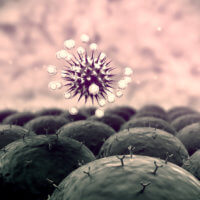
Mast cells: sentinels of the immune system
Mast cells are white blood cells found in all human tissues, especially at places where the body interfaces with the environment, like the gut and skin. Though best known for their role in allergies, mast cells are also involved in the formation of new blood cells, wound healing, the development of immune tolerance, defense against pathogens, and the maintenance of blood-brain barrier function (1, 2). Mast cells are the sentinels of the innate immune system, on the lookout for environmental changes or insults to the body. They respond by releasing mediator molecules that influence the behavior of other cells and tissues in an effort to maintain normalcy, or “homeostasis.” There are over 200 of these mediators stored within the granules of mast cells, including tryptase, prostaglandins, leukotrienes, and histamine (3). Histamine often gets a particularly bad rap, but it has many important physiological functions in the body: acting as a neurotransmitter, regulating stomach acid secretion, and playing a role in the local and systemic immune response (4). The key takeaway here is that we need mast cells and their mediators for normal body function. The issue arises when these cells become overactive, as they do in individuals with MCAD.Mast cell activation disorder: the hidden diagnosis
Mast cell activation disorder is characterized by the accumulation of mast cells that are genetically altered (mastocytosis) and/or the abnormal release of mast cell mediators (Mast Cell Activation Syndrome). Because mast cells are found in all human tissues, and mast cell mediator receptors are found on almost every cell in the body, MCAD has the potential to affect every organ system (5). MCAD presents clinically as a chronic, multisystem pathology of a generally allergic and inflammatory theme, and has been associated with obesity, diabetes, skin conditions, irritable bowel syndrome (IBS), depression, and more (6). MCAD does have a genetic component, and tends to cluster in families (10), though related individuals may present with very different symptoms (11).Trouble with histamines? Get to the root of the problem.MCAD is estimated to be more prevalent (7) than other diseases of mast cell dysfunction, but also more difficult to recognize. This is at least in part due to the fact that it often does not cause abnormalities in routine lab testing. MCAD was not named as a condition until 2007 (8) and diagnostic criteria weren’t proposed until 2010 (9).
Finding the root cause of MCAD
In the functional medicine model, we always seek to address the root cause of disease, as opposed to just treating symptoms. We still have a lot to learn about MCAD, but I believe it is likely the result of deeper pathologies, including: Heavy metal toxicity: Heavy metals like aluminum and mercury have been shown to destabilize mast cells. This makes sense, as the very purpose of using these as vaccine adjuvants is to elicit a heightened inflammatory immune response. Lead, cadmium, and bismuth have also been found to activate mast cells and cause mast cell mediator release (12). Infections or gut dysbiosis: The gut is home to 70% of the immune system (13), including a large number of mast cells. Parasitic infections, bacterial/viral infections, or bacterial/fungal overgrowth activate mast cells (14). Helminth parasites and Candida have been shown to be potent stimulators of mast cell activation (15, 16). Mast cells regularly interact with microbes, and gut dysbiosis itself may lead to MCAD (17). CIRS: Chronic Inflammatory Response Syndrome could also play a role. Those who are particularly susceptible to mold and have a reduced ability to clear mycotoxins from the body, which leads to a constant activation of mast cells.Treatment for MCAD
Conventional treatments for MCAD are pharmacological agents that block the action of mast cell mediators. While these may provide much-needed relief to patients, they are not a long-term solution and can have unwanted side effects. Safer short-term action steps that you can take to provide some relief include:- Adopting a low-histamine diet: For some people with MCAD, a low-histamine diet provides significant relief. Supplemental diamine oxidase can also help by increasing histamine breakdown. But, it’s important to keep in mind that this is only reducing exogenous (outside) histamine, and not altering the amount produced by your mast cells endogenously (within the body). Histamine is also only one of many mediators produced during mast cell degranulation.
- Focus on nutrients and foods known to stabilize mast cells: Many nutrients, including selenium (18) and vitamin C (19), have been shown to stabilize mast cells. A number of herbs and spices, like holy basil (20), peppermint (21), ginger (22), thyme (23), and turmeric (24) also have this effect. I have also seen good results with supplemental forms of quercetin (25), bromelain, nigella sativa (26), nettle (27), and butterbur (28).
- Reducing stress: Corticotropin hormone, released in response to physical or psychological stress, destabilizes mast cells and causes them to release their mediators (26).
- Entraining circadian rhythms: Mast cell activity closely mirrors circadian rhythms (27), so getting enough sleep and avoiding blue light at night is crucial.
- Remove heavy metals from your system: Chelating agents can help to remove heavy metals from your system. This is best done under the guidance of a healthcare practitioner. Removal of old mercury fillings by a trained professional can also reduce the burden of heavy metals in the body.
- Treat infections: A comprehensive stool test can help identify parasites and other infections that could be contributing to mast cell activation.
- Heal your gut: Remove inflammatory foods and focus on nutrient density. Include plenty of probiotic, prebiotic, and healing foods in your diet.
from Chris Kresser http://chriskresser.com/could-your-histamine-intolerance-really-be-mast-cell-activation-disorder/
via Holistic Clients
No comments:
Post a Comment